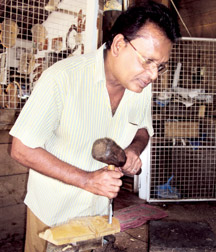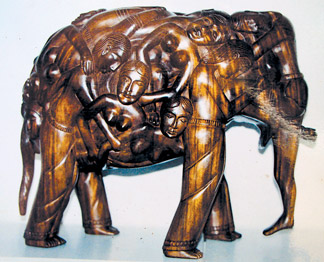Ebony dates back to 150 years:
A huge root, a memento
By Ananda Kannangara
 |
| Benedik Perera |
 |
| Jayalal
Priyantha |
Could you believe that a person keeps a 150-year-old root of a tree
as a memento? It is an interesting story from the Dunagaha village in
Beruwela, where Samuwel Ranatunga, 91, keeps a huge root as a memento.
The root of this ebony tree was given to him by his grandfather 80 years
ago.
Samuwel who is feeble and walks with the help of a walking stick said
the owner of the root was a British national. He said during colonial
days the British had a habit of visiting Beruwela to purchase gem stones
from Muslim merchants.
One day, Samuwel's great grandfather had gone to a forest in the
Dunagaha village with a British national on a hunting trek. While
hunting they spotted a fallen tree with long roots. The roots had spread
in the shape of a tusker with a baby elephant. Two separate long roots
of the tree represented the tusks of the elephant. It was a unique root.
The Englishman was amazed by the sight of the root which he had seen for
the first time in his life. He abondoned the idea of hunting and
pursuaded Samuwel's great grandfather to separate the root from the
tree. The root was separated using a saw. However, the Englishman was
not permitted to take the heavy root to his country owing to strict
regulations and therefore he left it at Semuel's grea grandfather's
home. The root was cleaned and polished by him.
Samuwel said the huge root in the shape of a tusker and baby elephant
could now be sold for as high as Rs.250,000. Although several tourist
hotels had inquired from him about the rare creation with a desire to
place it at the entrance of their hotels, he had not consented as it has
been with his generation from the 19th century.
Samuwel said thousands of people would have seen the rare root and it
could have led to the origin of the Sri Lankan root creation industry.
At present, the art of designing creations from roots is carried out
by people in Kataragama, Yala, Ambalangoda, Anuradhapura, Sigiriya and
Polonnaruwa where thick jungles are found. People bring small and large
roots of trees and cut them into shapes of animals, humans or birds.
Samuwel said the 150-year-old rare root is natural and not manually
shaped as a tusker and baby elephant.
Asked whether he has any facts to prove that the root was
150-years-old, he recollected his memory and said his grandfather who
was born in 1864 had related this story to his father James Appuhamy.
Samuwel said he was 91 years and his youngest son Nandasena who is 60
and a retired teacher is the sole owner of his properties including this
unique root creation.
Samuwel said the root had a history and therefore he asked his son to
gift it to the Colombo Museum during his lifetime.
The Sunday Observer last week visited several villages in the South
including the historical cities of Aluthgama, Beruwela and Ambalangoda
to meet people who are engaged in root creations (Ruk Kala) and wood
carving (Lee Ketayam) industries.
Our visit to Aluthgama in search of people engaged in wood carving
was very interesting as we were able to meet four prominent wood carving
manufacturers. At one place we saw foreign tourists choosing items of
wood carvings. A long-standing wood carving manufacturer, Benedik Perera
50, said he started the industry at the age of 15 and he had 35-years
experience in the field of wood carving.
Benedik said, wood carvings could be done from timber including
Karuwala, Mahogani, Mara, Teak, Burutha and Palu. Most people
manufactured items from Karuwala due to the shortage of other timber
such as Mahogani and Mara.
In the early days people went to forests and cut down valuable trees
to make wood creations, but due to the destruction of valuable forests,
rules and regulations have been imposed by the authorities. As a result,
workers engaged in the wood carving industry have to buy timber from the
State owned Timber Corporation by producing permits.
Benedik is of the view that about 100 families in Aluthgama,
Ambalangoda, Beruwala and Kalutara areas are engaged in the wood carving
and root creation industry and the Government should encourage them by
conducting regular exhibitions. He said most tourists from countries
such as the Middle East, India and Pakistan who visit Sri Lanka do not
spend money on wood carvings or other traditional items.
He proposed the Sri Lanka Tourism to encourage tourists from European
countries as they spent on traditional items including wood carvings.
|

An elephant carved in wood at Ambalangoda |
Benedik has won several prizes for his wood creations. One of his
wood creations was selected as a best creation by a German organisation
in 2008 and he was invited to the ` 'Internationales Holzbildhauers
Symposium' in Germany.
During our short stay in the Heralanthuduwa Village in Beruwela,
Jayalal Priyantha 43, who is engaged in wood carvings said tourists were
also attracted to masks and puppets.
He said according to Sri Lanka Tourism, over 200,000 tourists passed
Beruwala and Ambalangoda on their way to the South to spend their
vacations annually and proposed to the authorities to establish a
handicraft village in Amabalangoda, so that the craftsmen could sell
their products easily and quickly. A prominent wood carving
manufacturer, Nihal Gunakanda who owns a showroom at Ambalangoda said he
started manufacturing wood carvings from his school days and later on
started a showroom intending to sell them to foreign tourists.
As wood carvings are expensive, they are mainly purchased by
foreigners and hotel owners
He said that a separate Ministry has been set up by the Government to
develop the traditional craft industry in the country and requested the
authorities to look into the welfare of the craftsmen.
They should be registered with the area Divisional Secretariats and
granted bank loans.
Kumarasiri Gallage of Kalutara said many people engaged in wood
carving sell their products to tourist hotels at very cheap rates and
called upon the authorities to instruct tourist bus operators to visit
their sales centres to buy them at reasonable prices.
He said unlike in the past, foreigners bought small quantities of
wood carvings due to restrictions and laws imposed by the Government
when taking them to foreign countries. A wood carving manufacturer, D.R.
Sumanasiri 54, said in addition to wood carvings, he sold antique items
to foreigners. He said he visits houses to collect antique items. But
some people would not sell them, and kept them as mementos.
He said although foreigners are interested in our wood carvings, most
of them are reluctant to buy them due to the strict regulations imposed
by the Government to stop them from taking them out of the country.
He requested the authorities to release the restrictions and allow
foreigners to take our traditional items including wood carvings to
their countries. |



